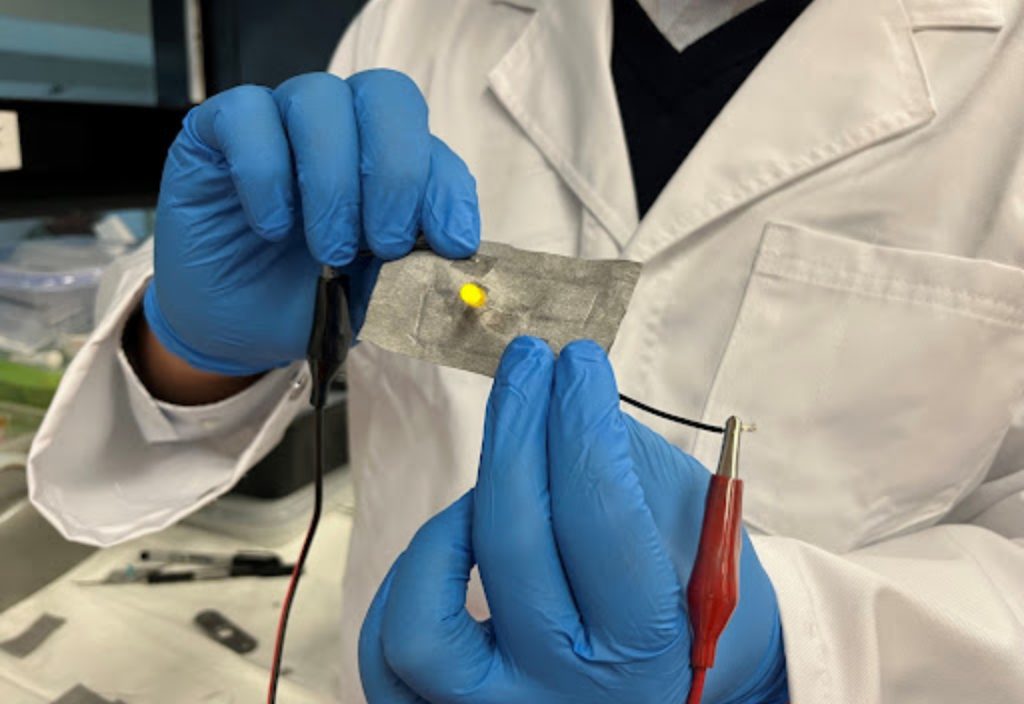Hospitals are rife with dangerous bacteria, with an overuse of antibiotics causing resistant strains. This liquid metal coating for monitoring garments both protects vulnerable patients and self-repairs.
It was a scary world before penicillin became commercially available in the mid-1940’s. Strep throat was a common killer, and a simple ear infection could spread to the brain, causing meningitis.
Now, the overprescribing of antibiotics, fuelling the rise of mutant strains of pathogenic bacteria, could return us to that bleak scenario.
The looming global health threat that is antimicrobial resistance led to 1.27 million global deaths in 2019 alone, which could skyrocket to 10 million fatalities by 2050. Vulnerable groups such as the immunocompromised are even more susceptible to resistant bacterial infections.
As a biomedical nanoengineer who spent many years developing antimicrobial technology, Flinders University Lecturer Dr Vi-Khanh Truong was determined to design a product that moves away from our heavy reliance on antibiotics.
The innovation, a bacteria-repelling liquid metallic coating for wearable textiles, was first designed for use on electrocardiogram (ECG) vests that measure the heart’s electrical activity.
“The coating was developed especially for people who have ECGs, reducing the need for alcohol swabbing and the chance of cross-contamination, which actually leads to the use of antibiotics,” said Truong.
“These patients may be immunocompromised or have chronic diseases such as diabetes, and because they come into hospital for ECGs quite often, the chances of [picking up] bacteria are really high.”
The dual-purpose coating was also principally designed to be self-healing, reducing wear and tear to preserve the conductive function of ECG vests so they can effectively monitor patients’ vitals.
“When patients go in for an ECG, doctors want to see how they move around while recording the heartbeat. Over time the textile can crack, breaking the conductive pathway,” he said.
“But the liquid-metal coating autonomously heals, forming a new conductive pathway that maintains conductivity as well as providing anti-microbial properties.”
An innovative conductive material
When selected for a prestigious Fulbright Fellowship, Truong had the opportunity to work at North Carolina University under mentor Professor Michael Dickey, a pioneering liquid metal engineer.
It was at NC State that he pitched the idea for the liquid metal coating to Prof Dickey, suggesting gallium for its high antimicrobial performance – with compounds already proven to treat Pseudomonas aeruginosa lung infections in clinical trials.
“Prof Dickey then explained gallium’s oxidation process, so we assembled a team to work together on [the design],” said Truong.
Most of the conductive materials used in monitoring garments are hard metals such as gold or copper. While seemingly durable, ongoing bending motions can lead to crack formations that cannot be healed. Truong likens this to bending a stick. Once its elastic limit is surpassed, it breaks.
However, with its low melting point of 30 degrees Celsius, metallic electrical conductivity and high thermal conductivity, gallium-based liquid metals provide an excellent conductive pathway while remaining liquid when applied to a human body.
“It’s like taking a knife and cutting into water,” he said. “Because it’s a liquid, it doesn’t break and it keeps flowing.”
When exposed to air, gallium-based liquid metal particles form a single oxide layer, similar to the skin on a blueberry.
Movement during an ECG is akin to scraping the surface of the blueberry – exposing the liquid.
“If you press it down, the blueberry breaks and the fluids come out, which in turn creates a conductive pathway,” said Truong.
“The conductive patterns autonomously heal when cut by forming new conductive paths along the edge of the cut, providing a self-healing feature which makes these textiles useful as circuit interconnectors, Joule heaters and flexible electrodes to measure ECG signals.”
The coating in action
Let’s say a patient comes in for a scheduled ECG. Prior to the procedure, the coating is applied to the vest’s fabric by dipping it into a suspension of gallium-based liquid metal particles at room temperature.
“Evenly coated textiles remain electrically insulating due to the native oxide that forms on the liquid metal particles. However, the insulating effect can be removed by compressing the textile to rupture the oxide and thereby allow the particles to percolate,” said Truong.
“This enables the creation of conductive circuits by compressing the textile with a patterned mould. The electrical conductivity of the circuits increases by coating more particles on the textile.”
Providing antimicrobial protection against Pseudomonas aeruginosa and Staphylococcus aureus, the coating also protects patients from harmful germs while preventing the ECG vest’s porous material becoming contaminated through use over an extended period of time or among different patients.
Scaling up
Producing liquid gallium particles is simple and non-intensive, relying on a one-pot nanoprobe sonication method – making it a “green” technology that’s easily scalable.
Given gallium is itself considered safe and non-toxic, the technology is at a readiness “level 6” following laboratory testing, with a verified prototype primed for development.
With cracking long being a problem for flexible devices, hindering the number of new products coming out – Truong is looking beyond the hospital setting for this potentially transformative product.
“It will be interesting to see [it applied to] human/machine interfaces, sensors, soft robotics and wearable electronic devices – providing a performance aspect while avoiding microbial cross infection at the same time.”
The new and improved Engineers Australia Excellence Awards are now open for nomination. Learn more about the awards program and how to nominate here.
